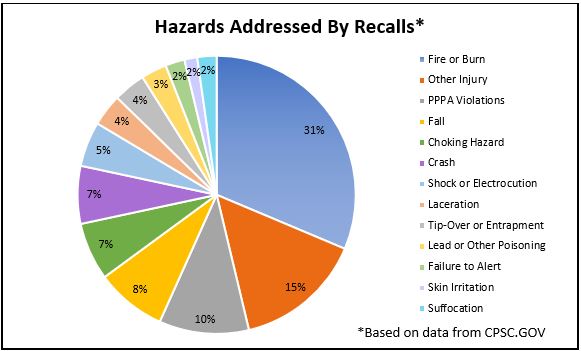Recalls in Review: A monthly spotlight on trending regulatory enforcement issues at the CPSC.
As we launch into the third quarter of 2021, we have taken a look back to identify and highlight trends from the CPSC’s recalls through the first half of the year. The Commission has conducted 134 total recalls so far this year—about ten fewer recalls than in the first half of 2020. The types of products recalled vary widely, including ATVs and UTVs, bicycles, kitchen appliances and cooking utensils, exercise equipment, toys, essential oils, portable generators, charging cords, and heavy machinery, among many others.
Some product categories have appeared on a repeat basis this year, including: furniture, recreational vehicles, such as ATVs, UTVs, and motor bikes, and children’s clothing. The Commission has recalled furniture and recreational vehicles at a fairly consistent rate since January. The rate of recalls for recreational vehicles, which have historically been highly regulated, is on par with 2020 and past years as well. However, the recalls of children’s clothing began much later in the year. That upswing is largely attributable to recalls of children’s jackets and sleepwear.
Risk of fire or burn is the most common hazard addressed by the recalls from the first half of the year. Approximately 31% of the recalls address fire or burn risks, which is a 12% increase compared to the first half of 2020. Product types recalled due to a fire or burn risk include propane heaters, personal electronics, children’s sleepwear, recreational vehicles, kitchen appliances and eating utensils, other home appliances, a mattress, and candle-related products. The majority of these products were not recalled until after incidents involving the product were reported to either the recalling firm or the CPSC. Accordingly, consumers should carefully monitor the products in their homes that may pose fire or burn risks.
Another 13% of the recalls address violations of the Poison Prevention Packaging Act (PPPA) and other poisoning risks, which represents a 10% decrease compared to the first half of 2020. The product types recalled due to violations of the PPPA include chemical products, such as those that include sodium and potassium hydroxide, prescription drugs, supplements, and essential oils. The number of essential oil recalls conducted this year (4 recalls) has decreased dramatically in comparison to the first half of 2020 (20 recalls). As mentioned in our previous post on Recall Trends in 2020, the then-recent rise in essential oil recalls correlated with at least one consumer advocate helping the CPSC to identify products in violation of PPPA requirements by reporting such products through saferproducts.gov. Essential oils are a great example of how quickly CPSC enforcement trends can change alongside changes in consumer concerns and market trends.
Children’s product recalls have steadily increased as the year progresses, even when the total number of products recalled dipped in both March and June. Children’s product recalls represent a larger proportion (23%) of the total number of 2021 recalls as compared to 2020 (19%), but are roughly proportionate to other recent years—24% in 2019, 20% in 2018, and 33% in 2017. Over two-thirds of the children’s products recalled this year were subject to recall despite having no reported incidents involving the product, which is not uncommon for recalls that address violations of federal lead standards, the PPPA, and the Federal Hazardous Substances Act (which governs the flammability of clothing, among other hazards). Consumers and industry members should continue to carefully monitor CPSC.gov or saferproducts.gov for children’s product recalls as we enter the back-to-school and holiday shopping seasons.
* * * * *
About Recalls in Review: As with all things, but particularly in retail, it is important to keep your finger on the pulse of what’s trending with consumers. Regulatory enforcement is no different—it can also be subject to pop culture trends and social media fervor. And this makes sense, as sales increase for a “trending” product, the likelihood of discovering a product defect or common consumer misuse also increases. Regulators focus on popular products when monitoring the marketplace for safety issues.
As product safety lawyers, we follow the products that are likely targets for regulatory attention. We share our observations with you through Recalls in Review.


